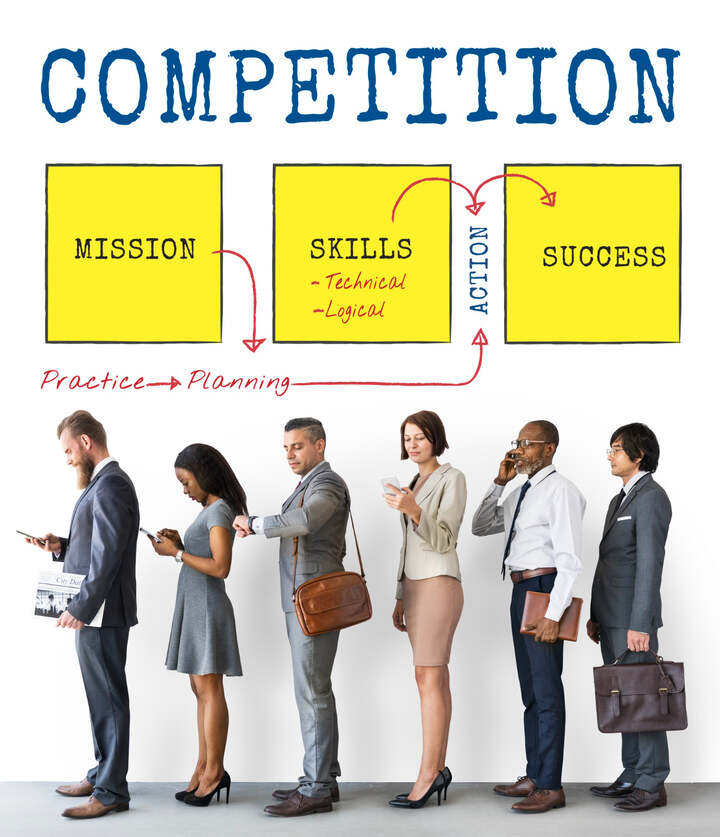Building a successful career does not happen by chance. It also takes a clear strategy, hard work and a future dream. It is because of this that it is necessary to have a clear-cut career roadmap strategy. This plan is your compass telling you where you are today, where you want to be and the steps you need to pursue to achieve that.
You may not have a plan, hence making some random career moves that may not align with your long-term objectives. A roadmap will allow each step you take to help your professional growth. A decisive path that controls the direction of employees during their careers is structured when pursuing a first job or intending to change careers. This is because a structured plan will keep you focused, make better decisions, and ultimately attain success within a short time.
Within this guide, we shall look at the seven key steps to a great roadmap for your career. The steps will direct you to reach objectives and attain skills. It’ll go forward on a path to meet your ambitions.
Step 1: Define Your Long-Term Vision
All successful careers begin with a clear vision. Your vision must explain how you would like your professional life to appear in 5 years or 10 years or even 20 years ahead.
Ask yourself questions like:
- What role do I want to have?
- Which industry inspires me the most?
- What kind of impact do I want to make?
Once you have your vision, write it down. This should be the basis of your roadmap. A clear vision serves as a filter to enable you to distinguish between different opportunities and make decisions which will guide you toward your ultimate goal. Without it you might get into precisely overnight gains that simply aren’t leading towards longer term targets.
Step 2: Assess Your Current Position
Before you can plan your career journey, you must know exactly where you are today. This step is about clarity. It’s like checking your current location before using a map, without it, you can’t navigate effectively.
Here’s how to break it down:
- Skills Audit
Possess a record of all your skills. These can be technical skills, software skills, leadership skills or problem solving skills. Honestly grade yourself on each of the skills. To take an example, in case you have knowledge of Python but just on a beginner level, mention it as a beginner. - Experience Review
Think back on job history, internships, part-time volunteer and project work. Write a record of the best things that you are proud of. These would be noteworthy projects, leadership or output deliverables that you achieved. - Gap Analysis
Take stock of what you know/what you can do now relative to what your dream job needs. Identify the areas of weakness, maybe you lack certification or skills in management or real-life experience in the industry.
Step 3: Set SMART Goals
A career roadmap strategy can only succeed if your objectives are well outlined and realistic. Enter in here the SMART framework which highlights that your goals are Specific, Measurable, Achievable, Relevant, and Time-bound.
Here’s what that looks like in action:
- Specific: State exactly what you aim to do. Instead of saying “I want to get better at coding,” say, “I will master JavaScript for web development.”
- Measurable: Decide how you will measure success. For coding, you could track completion of specific projects or certifications.
- Achievable: You need to ensure your goals are not easy, but attainable. It is not possible to have a goal of being a CTO within two months but one can have a goal of being a team lead in two years.
- Relevant: Having a career vision should make every objective bring you a step closer to it. It is important to avoid unrelated accomplishments that will cause distraction.
- Time-bound: Deadlines create urgency. “I will complete an advanced Python course within six months” is better than “I will learn Python someday.”
SMART goals keep you focused and accountable, turning vague ambitions into actionable steps.
Step 4: Build Your Career Roadmap Strategy
Does your plan consist essentially in getting out of where you are, to where you wish to be. Divide it into short- term, mid-term and long-term actions.
- Short-Term Actions (0–6 months):
These are momentum builder’s quick win’s. These have included taking a course to certification, creating a new and improved LinkedIn profile or joining a professional association. - Mid-Term Actions (1–3 years):
These take up more time, effort. Examples are such as managing a team project, mastering a new programming language or moving into a novel post. - Long-Term Actions (3+ years):
These are the end career goals in line with your career, like department head, starting your own company or working in an international company.
By breaking your career journey into manageable steps, you reduce overwhelm and increase your chances of staying consistent.
Step 5: Invest in Skill Development
Success in a career is based on skills. They are indispensable, without which no better-laid roadmap can be effective. Attention to two types:
- Core Skills: These are the skills in your occupation. In the case of IT, it may be programming, cloud computing or cybersecurity. As far as marketing is concerned, it may be branding, analytics or SEO.
- Soft Skills: These are equally important. Communication, leadership, critical thinking, and adaptability are valued in every industry.
Make skill-building an ongoing habit:
- Enroll in online courses (Coursera, Udemy, LinkedIn Learning).
- Attend workshops and industry conferences.
- Join communities where you can learn from peers.
Every new skill boosts your value in the job market and opens doors to better opportunities.
Step 6: Build a Professional Network
Networking is more than exchanging business cards or adding people on LinkedIn, it’s about building relationships that help you grow.

Practical networking steps include:
- Attend Industry Events: Conferences, meetups, and workshops are great places to meet professionals in your field.
- Join Professional Associations: Being part of a recognized group increases your credibility.
- Engage on LinkedIn: Share insights, comment on posts, and connect with people whose work you admire.
- Find Mentors: A mentor can guide you, open doors, and help you avoid common mistakes.
Personal recommendations lead to many career breakthroughs, whereas job boards are not the ones. These opportunities that have been concealed are available through a good network.
Step 7: Monitor and Adjust Your Plan
Your career roadmap is not static, it should adapt as industries evolve and your interests change.
Every 6–12 months, ask yourself:
- Am I closer to my long-term vision?
- Have my priorities shifted?
- Do I need to learn new skills or update my goals?
Assuming your industry revolutionizes, say because of a new technology, then your plan needs to show that. Versatility renders your plan current and makes your profession progress.
Check-ups also make you stay motivated. One is able to celebrate success, plan on what needs improvement and remain in pace with the greater vision.
Extra Tips for a Strong Career Roadmap
- Stay Flexible: Your goals may change as you grow. Be open to new possibilities.
- Seek Feedback: Regular feedback from mentors can keep you on track.
- Document Progress: Keep a record of completed courses, certifications, and projects.
- Celebrate Milestones: Recognize and reward yourself for achievements.
Why a Roadmap Matters More Than Ever
The Fast-Changing Job Market
The current job market is one of the fastest-changing. New technologies appear, the industries change, and the competition in the global world increases. Even a stable profession changes overnight, leaving professionals without knowing what to do next. Failure to have a strategic plan in place makes it hard and stressful to adjust to such changes.
Anticipating and Preparing for Change
A career roadmap can enable you to forecast things happening in the industry and prepare in time. The gaps in skills can be identified, the learning objectives can be set, and opportunities can be selected that will keep one ahead. You are not just responding to changes now and then, but rather you are out there being proactive, which puts you in control of your career. This is to be prepared in advance so that you get ready whenever new demands come in, however fast.
Building Confidence and Competitive Advantage
You become clear on what you want to do or want to be. You are familiar with achievements and their pathway, and the skills you must gain. The result is that this clarity increases confidence and makes you make better decisions. It also makes you competitive, giving you an advantage in terms of becoming more adaptable and able in a workplace that keeps changing.
Real-Life Example: From Intern to Manager
Consider the case of Sara, a marketing graduate. She began her career as an intern in a small agency. She had a clear vision: to lead a digital marketing department within five years.

Here is how she followed her plan:
- Defined her vision and assessed her skills.
- Set SMART goals like completing certifications in SEO and social media marketing.
- Built her roadmap with short-term tasks like managing small projects.
- Networked with industry professionals and found a mentor.
- Would check up on her improvement after every six months and change her tactics.
In five years, Sara had been appointed the leader of a marketing team in a bigger organization. Her success shows the power of a well-planned roadmap.
Conclusion
A clear plan is capable of making career aspirations come true. You need to start by building a clear vision of the future and need to identify what you are capable of at the moment. Follow this up by developing SMART goals, which are specific, measurable, achievable, relevant and time-bound. Have the proper outline of the steps you should take in achieving your goals.
This is where the career roadmap strategy is the difference. It helps fix your attention on what is important to you, is motivated to action and is flexible when changes happen in your industry. Your career will never be in a straight line, and it is a journey where there will be a choice of learning options and growing. Being able to check off all the skills you learn, the connections and interactions you establish, and the milestones, these things bring you a step closer to your ultimate goal.
Do consistent, stick to your strategy and change direction when necessary. Having an appropriate roadmap allows you to overcome the difficulties, use the opportunities, and build the professional future of your choice. Begin designing your game plan now and take the lead in your professional career.

